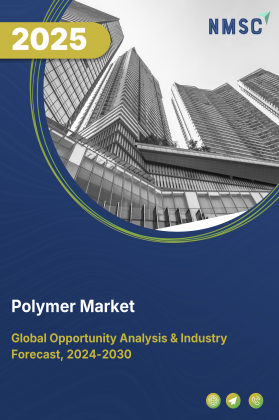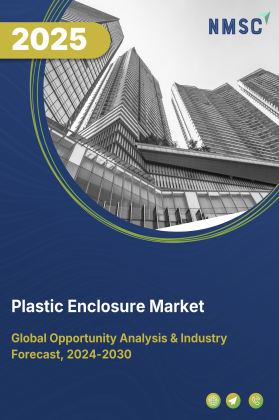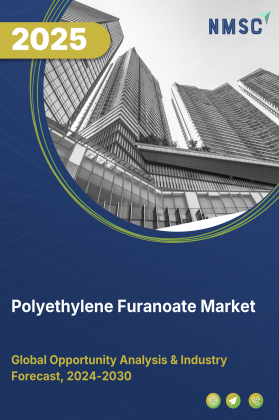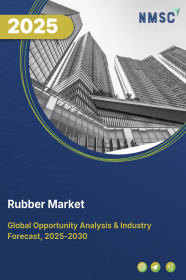
Polymer Market by Material (Polyethylene, Polypropylene, Polyvinyl Chloride, Polyethylene Terephthalate, Polystyrene, Polyurethane), by Polymer Type (Conventional Polymers, Specialty & Advanced Polymers), by Processing Method (Polymerization, Specialized, Fabrication & Shaping), by Application (Packaging, Construction & Building Materials, Automotive & Transportation, Electrical & Electronics, Medical & Healthcare, Others) – Global Opportunity Analysis and Industry Forecast, 2025–2030
Industry Overview
The global Polymer Market size was valued at USD 818.93 billion in 2024 and is predicted to reach USD 866.43 billion by the end of 2025. The industry is predicted to reach USD 1148.58 billion by 2030 with a CAGR of 5.8% from 2025 to 2030.
The market is experiencing steady growth, driven by rising demand from key sectors such as packaging, automotive, transportation, and construction. The packaging industry remains a dominant consumer, fuelled by increasing consumption of packaged food, beverages, pharmaceuticals, and personal care products, while the automotive sector leverages lightweight, durable polymers to enhance fuel efficiency and meet emission standards, with electric vehicles further accelerating adoption.
In construction, polymers are essential for piping, insulation, flooring, and cable applications due to their durability and resistance to harsh conditions. However, market growth faces challenges from environmental concerns and stringent regulations on plastic waste, prompting the need for sustainable solutions. This shift is creating significant opportunities for biodegradable and bio-based polymers, as advancements in green technologies open new applications across industries, positioning sustainability as a key growth driver in the coming years.
Growing Demand from Packaging Industry Boosts the Market Growth
The packaging sector is one of the largest consumers of polymers, with applications spanning flexible films, bottles, containers, and protective materials. Rising demand for packaged food, beverages, pharmaceuticals, and personal care products, driven by urbanization, changing lifestyles, and the expansion of e-commerce, is significantly boosting polymer consumption.
Materials such as polyethylene (PE), polypropylene (PP), and polyethylene terephthalate (PET) are preferred for their lightweight nature, durability, moisture resistance, and cost-effectiveness. Furthermore, innovations in sustainable packaging, including recyclable and biodegradable polymer materials, are further fuelling market growth, as industries seek to meet consumer preferences and comply with environmental regulations.
Rising Use in Automotive and Transportation Drives the Market Expansion
The automotive and transportation industries are increasingly adopting polymers to replace traditional metals, driven by the need for lighter, more fuel-efficient vehicles and compliance with stringent emission regulations. Polymers such as polypropylene (PP), polycarbonate (PC), and acrylonitrile butadiene styrene (ABS) offer high strength-to-weight ratios, corrosion resistance, and design flexibility, making them ideal for applications in interiors, exteriors, under-the-hood components, and structural parts.
The rise of electric vehicles (EVs) is further accelerating polymer demand, as lightweight materials help extend driving range and improve energy efficiency. Additionally, the cost-effectiveness and ease of mass production of polymer components contribute to their growing use across the transportation sector.
Expansion of Construction and Infrastructure Activities Fuel the Market Demand
Rapid growth in construction and infrastructure development is a major driver for the polymer market demand, as polymers are extensively used in building materials, piping systems, insulation, flooring, and cable sheathing. Increasing urbanization, government-led housing projects, and large-scale infrastructure investments in developing economies are boosting demand for durable, lightweight, and cost-efficient polymer products.
Materials like polyvinyl chloride (PVC), high-density polyethylene (HDPE), and polypropylene (PP) are preferred for their resistance to corrosion, weathering, and chemical exposure, ensuring long service life in demanding environments. Moreover, advancements in polymer technology, including energy-efficient and sustainable building materials, are further expanding their role in modern construction.
Environmental Concerns and Stringent Regulations Limits the Polymer Market Growth
One of the key restraints for the polymer market expansion is the growing concern over plastic waste and its environmental impact. The persistence of non-biodegradable polymers in landfills and oceans has led to stricter regulations on plastic production, usage, and disposal in many countries.
Government bans on single-use plastics, mandatory recycling targets, and rising consumer preference for eco-friendly alternatives are creating challenges for conventional polymer manufacturers. Compliance with these regulations requires investment in research, development, and production of sustainable or biodegradable materials, which increase operational costs and impact profitability.
Rising Demand for Biodegradable and Sustainable Polymers Creates New Growth Opportunities
An important opportunity for the market lies in the increasing demand for eco-friendly and biodegradable materials. With governments, industries, and consumers prioritizing sustainability, there is growing interest in polymers derived from renewable resources such as corn starch, sugarcane, and cellulose. These materials offer similar performance to conventional plastics while reducing environmental impact.
Advancements in green polymer technologies, such as polylactic acid (PLA), polyhydroxyalkanoates (PHA), and bio-based polyethylene (bio-PE), are opening new growth avenues in packaging, agriculture, medical devices, and consumer goods. Companies investing in sustainable polymer solutions gain a competitive edge and tap into emerging high-value markets driven by environmental regulations and shifting consumer preferences.
Market Segmentations and Scope of the Study
The market report is segmented by material, polymer type, processing method, application, and regions. Materials include polyethylene, polypropylene, polyvinyl chloride, polyethylene terephthalate, polystyrene, and polyurethane, each serving distinct performance needs. Polymer types range from conventional polymers, thermoplastics, thermosets, elastomers, and fibers, to specialty and advanced variants such as engineering, high-performance, smart, bio-based, and medical polymers. Processing methods cover polymerization techniques, specialized processes, and fabrication methods like injection molding, extrusion, blow molding, and 3D printing. Applications include packaging, construction, automotive, electronics, healthcare, textiles, agriculture, and industrial uses. Geographically, the market spans North America, Europe, Asia-Pacific, and the Rest of the World, reflecting diverse demand across multiple sectors.
Geographical Analysis
In North America, the polymer market share is driven by robust demand from advanced packaging and consumer goods industries. The region’s mature food and beverage sector, coupled with the growth of e-commerce, has increased the need for high-performance packaging materials such as polyethylene (PE), polypropylene (PP), and polyethylene terephthalate (PET). These polymers offer durability, lightweight properties, and superior barrier protection, making them ideal for preserving product quality and extending shelf life. Additionally, rising consumer preference for convenience packaging and innovations in recyclable and sustainable polymer solutions are further fuelling market growth in the region.
In Europe, the market is strongly driven by the rising demand for both flexible and rigid packaging solutions, particularly in the food, beverage, healthcare, and personal care sectors. Flexible formats such as films and pouches, primarily made from polyethylene (PE) and polypropylene (PP), are valued for their lightweight, durable, and moisture-resistant properties, while rigid formats like PET bottles and containers offer strength and product protection. The growth of e-commerce, increasing consumer preference for convenience packaging, and the push for sustainable, recyclable materials are further accelerating polymer consumption across the region’s packaging industry.
In Asia–Pacific, the industry is gaining momentum from the rapid growth of automotive and electronics manufacturing, with India emerging as a key contributor. According to India Brand Equity Foundation (IBEF) in 2025, two-wheelers and passenger vehicles dominate the domestic Indian auto market, accounting for 76.57% and 16.80% of market shares, respectively, in FY25. This strong automotive base, along with robust production of consumer electronics in countries like China, Japan, and South Korea, is driving demand for high-performance polymers such as polypropylene (PP), acrylonitrile butadiene styrene (ABS), and polycarbonate (PC). These materials offer lightweight, durable, and versatile properties, supporting fuel efficiency in vehicles and compact, long-lasting designs in electronics, thereby fuelling polymer consumption across the region.
In the Rest of the World (RoW), particularly in regions like the Middle East, Africa, and Latin America, the market is driven by rising infrastructure development and industrial expansion. Large-scale investments in construction, oil & gas, mining, and manufacturing sectors are fueling demand for polymers used in pipes, fittings, insulation materials, and industrial components.
Countries rich in natural resources are leveraging their energy and petrochemical industries to produce polymer-based products locally, reducing import dependence and supporting domestic markets. Additionally, growing urban populations and improving living standards in these regions are boosting demand for packaged goods, automobiles, and consumer products, further stimulating polymer consumption.
Strategic Innovations Adopted by Key Players
Key players in the polymer industry are actively pursuing product innovation, strategic partnerships, and international expansion to strengthen their global presence and address growing sustainability demands.
-
In April 2025, LyondellBasell produced over 200,000 tonnes of circular polymers in 2024, a 65% year-on-year increase, as it advances toward its 2030 goal of 2 million tonnes annually. Initiatives include a new recycling plant in Germany and expansion in the United States and China.
-
In March 2025, ExxonMobil introduced its Signature Polymers brand at Plastico Brasil 2025, consolidating its polyolefin portfolio, including specialty modifiers and advanced recycling technologies.
-
In October 2024, Asahi Kasei entered into a partnership with Aquafil to create a cellulose nanofiber and recycled ECONYL® polymer compound for 3D printing, targeting automotive and aerospace applications.
Key Benefits
-
The report provides quantitative analysis and estimations of the industry from 2025 to 2030, which assists in identifying the prevailing market opportunities.
-
The study comprises a deep-dive analysis of the current and future polymer market trends to depict prevalent investment pockets in the sector.
-
Information related to key drivers, restraints, and opportunities and their impact on the market is provided in the report.
-
Competitive analysis of the key players, along with their market share is provided in the report.
-
SWOT analysis and Porters Five Forces model is elaborated in the study.
-
Value chain analysis in the market study provides a clear picture of roles of stakeholders.
Polymer Market Key Segments
By Material
-
Polyethylene
-
Polypropylene
-
Polyvinyl Chloride
-
Polyethylene Terephthalate
-
Polystyrene
-
Polyurethane
By Polymer Type
-
Conventional Polymers
-
Thermoplastics
-
Thermosets
-
Elastomers
-
Fibers
-
-
Specialty & Advanced Polymers
-
Engineering Polymers
-
High-Performance Polymers
-
Smart / Stimuli-Responsive Polymers
-
Super Absorbent Polymers
-
Bio-based Polymers
-
Bioresorbable Polymers
-
Medical Polymers
-
Cyclic Olefin Polymers
-
Polymer Composites
-
By Processing Method
-
Polymerization Process
-
Addition Polymerization
-
Condensation Polymerization
-
Copolymerization
-
-
Specialized Processes
-
Suspension Polymerization
-
Solution Polymerization
-
Bulk Polymerization
-
-
Fabrication & Shaping
-
Injection Molding
-
Extrusion
-
Blow Molding
-
Compression & Transfer Molding
-
Rotational Molding
-
3D Printing
-
By Application
-
Packaging
-
Construction & Building Materials
-
Automotive & Transportation
-
Electrical & Electronics
-
Medical & Healthcare
-
Textiles & non-wovens
-
Agriculture & Horticulture
-
Industrial & Manufacturing
-
Others
By Region
-
North America
-
The U.S.
-
Canada
-
Mexico
-
-
Europe
-
The UK
-
Germany
-
France
-
Italy
-
Spain
-
Denmark
-
Netherlands
-
Finland
-
Sweden
-
Norway
-
Russia
-
Rest of Europe
-
-
Asia-Pacific
-
China
-
Japan
-
India
-
South Korea
-
Australia
-
Indonesia
-
Singapore
-
Taiwan
-
Thailand
-
Rest of Asia-Pacific
-
-
RoW
-
Latin America
-
Middle East
-
Africa
-
Key Players
-
BASF SE
-
Dow Inc.
-
Sabic
-
Covestro AG
-
Evonik
-
Eastman chemical company
-
DuPont de Nemours
-
Mitsui Chemicals India Pvt. Ltd.
-
LG Chem
-
Celanese Corporation
-
KURARAY CO., LTD.
-
Teijin Carbon Europe GmbH
-
Asahi Kasei Corporation
Report Scope And Segmentation:
|
Parameters |
Details |
|
Market Size in 2025 |
USD 866.43 Billion |
|
Revenue Forecast in 2030 |
USD 1148.58 Billion |
|
Growth Rate |
CAGR of 5.8% from 2025 to 2030 |
|
Analysis Period |
2024–2030 |
|
Base Year Considered |
2024 |
|
Forecast Period |
2025–2030 |
|
Market Size Estimation |
Billion (USD) |
|
Growth Factors |
|
|
Countries Covered |
28 |
|
Companies Profiled |
15 |
|
Market Share |
Available for 10 companies |
|
Customization Scope |
Free customization (equivalent up to 80 working hours of analysts) after purchase. Addition or alteration to country, regional, and segment scope. |
|
Pricing and Purchase Options |
Avail customized purchase options to meet your exact research needs. |

















 Speak to Our Analyst
Speak to Our Analyst





















